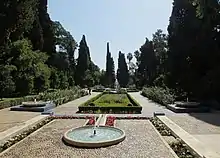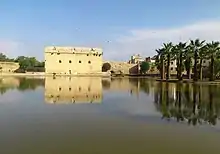Jnan Sbil Gardens
The Jnan Sbil Gardens (Arabic: جنان السبيل; also spelled Jnane Sbile from the French transliteration), also known as the Bou Jeloud Gardens, is public garden in Fez, Morocco, located between Fes el-Jdid and Fes el-Bali, the two sections of the old medina.

History
According to scholars, the gardens were created in the 19th century by Sultan Moulay Hassan I (ruled 1873-1894), who was responsible for building the walls which connected Fes el-Jdid with Fes el-Bali for the first time.[1][2]:296[3]:100 (Though regional tourism authorities claim the gardens date to the earlier reign of Moulay Abdallah in the 18th century.[4]) The gardens were placed inside the corridor between these walls, where the sultan also erected new summer palaces, such as the nearby Dar al-Beida ("White Palace" or "White House").[5][3]
The gardens were originally exclusive to royal elites and were connected to the Royal Palace by an underground passage, before being fully opened to the public in 1917.[5] After a period of neglect, they were recently renovated between 2006 and 2010 on the initiative of King Mohammed VI and reopened in 2011.[6][7]
Description


The gardens occupy approximately 7.5 hectares.[4][7] Today they are one of the few rare urban green spaces in the old city and are a popular leisure spot, especially at dusk.[8] They are decorated with colourful fountains and are planted with over 3000 species, including subsections labelled the "Andalusian Garden", the "Mexican Garden", and the "Bamboo Garden".[4] The garden is regularly open during daylight hours but is normally closed on Mondays.[7] It serves as one of the venues for the annual World Sacred Music Festival.[8][7]
The gardens are located along the course of the local river (the Oued Fes or Oued el-Jawahir) and the historic water channels which provided water to the old city.[3] Accordingly, some historic norias (water wheels) are also located in the area: one in the eastern part of the gardens and a larger one on the western edge of the gardens.[4][7] The southern part of the gardens is occupied by a large pool. The far side of the pool is overlooked by the old ramparts of Fes el-Jdid and by a large 16th-century Saadian bastion known as Borj Sheikh Ahmed.[3]
References
| Wikimedia Commons has media related to Jnan Sbil, Fes. |
- Bressolette, Henri; Delaroziere, Jean (1983). "Fès-Jdid de sa fondation en 1276 au milieu du XXe siècle". Hespéris-Tamuda: 245–318.
- Métalsi, Mohamed (2003). Fès: La ville essentielle. Paris: ACR Édition Internationale. ISBN 978-2867701528.
- Le Tourneau, Roger (1949). Fès avant le protectorat: étude économique et sociale d'une ville de l'occident musulman. Casablanca: Société Marocaine de Librairie et d'Édition.
- "Gardens and forests – Regional Council of Tourism FEZ". Retrieved 2020-03-19.
- Parker, Richard (1981). A practical guide to Islamic Monuments in Morocco. Charlottesville, VA: The Baraka Press. p. 126.
- "Jardin Jnan Sbil | Fes | Morocco | AFAR". www.afar.com. 2018-02-14. Retrieved 2020-03-19.
- "Fès/Tourisme: Jnane Sbil sur les traces du Jardin de Majorelle". L'Economiste (in French). 2019-05-17. Retrieved 2020-03-19.
- "Jnan Sbil | Fez, Morocco Attractions". Lonely Planet. Retrieved 2020-03-18.